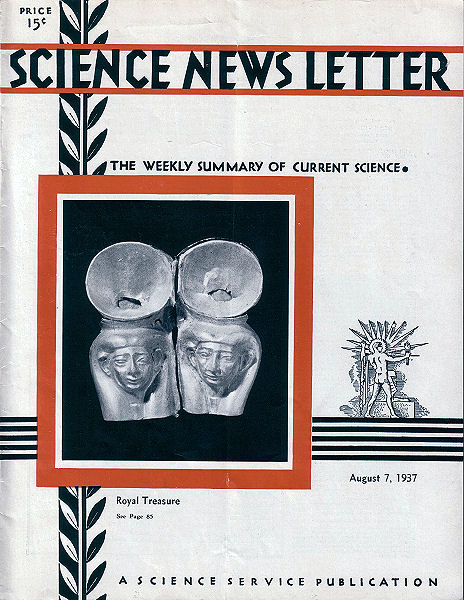From the August 7, 1937, issue

ANCIENT PALESTINE TREASURE COMES TO ORIENTAL INSTITUTE
An archaeological treasure in gold and ivory has arrived safely in Chicago, it was announced by Dr. John A. Wilson, director of the Oriental Institute of the University of Chicago. The treasure, from Megiddo (Armageddon) in western Palestine, was discovered during last season’s digging and a brief announcement was made last March, by cable.
The discoveries will have an important place in disclosing new knowledge of historic Palestine during the troubled years from 1500 to 1200 B.C., when the land was a loosely joined group of “city” states under the nominal leadership of Egypt.
Gordon Loud, field director of the Institute’s expedition, who has just returned from Palestine, related the details of the discovery.
“A magnificent palace,” he said, “with frescoed walls and floors of seashell mosaic stood just within the city gate and dominated the ramp approach to this fortress city. Within this palace lived princes of Megiddo who ruled this small section of the Egyptian Empire from about 1500 to 1200 B.C.”
UNCLE SAME HUNTS AMERICA’S FIRST HUMAN INHABITANTS
Uncle Sam is joining in the hunt for the most elusive people in America—our Ice Age inhabitants, if any.
Scene of the hunt is a farm near Trenton, N.J. Works Progress Administration workers, directed by well-known archaeologists, Dr. Dorothy Cross and Dr. Eugene Golomshtok, are digging for evidence there, where the last ice sheet left its debris of gravel when it melted back toward the northland.
Were there—or weren’t there—human beings already roaming America in those days, when the Ice Age ended? That is the most fought-over question in American science. If the answer is yes, then America has been inhabited at least 15,000 years.
Naturally, a country wants to know who its first inhabitants were, how long ago they arrived. But for America this has proved a baffling, long-drawn-out mystery.
Abbott Farm, scene of the WPA glacial-man hunt, has been famous in American science for over 60 years. As long ago as that, Dr. C.C. Abbott announced finding clumsy stone blades when he dug through black earth into a layer of yellow loam on his land. People who made the rude tools, he asserted, were older and more primitive than the well-known Delaware Indians who were in New Jersey when white men arrived.
In fact, Dr. Abbott was bold enough to suggest that these stone tools came to rest in the loam just above the glacial gravel in the very days when the glacier retreated.
That bombshell of an idea launched the scientific Battle of Trenton, in 1872, that is still going on.
In the course of years, there have been archaeologists who went to Abbott Farm and dug on comparatively small scale, just to see what they could learn. But they never found satisfying evidence to prove to their fellow prehistorians whether the stone blades were very ancient, or merely the handiwork of known Indian tribes.
In hope of getting somewhere with this argument, the WPA corps of workers is attacking systematically a field in Abbott Farm. They are using the latest approved technique of archaeological digging. That means squaring off the field by surveying methods, so that each small, 5-foot section of the site can be mapped, and anything found in it can be charted to show its exact resting place. To sample the possibilities of the field, trial trenches have been dug through the ground, and where pay dirt in the form of antiquities is struck, there more-intensive digging can be done.
EARHART PLANE LOSS STAYS COLLECTION OF MICROORGANISMS
Among the scientific experiments under way on the world-girdling flight of Amelia Earhart and Capt. Fred Noonan was one involving the collection of microorganisms from the air, it has been revealed by Fred C. Meier, chairman of the National Research Council’s Committee on Aerial Dissemination of Pathogens and Allergens. The objective of this committee is the charting and recording of the manner in which harmful organisms and material which produce allergy are transmitted. The equipment carried on the Earhart plane was of the type developed by Col. Charles A. Lindbergh and used by him in 1933 on the North Atlantic and Greenland flight with Mrs. Lindbergh.
“Miss Earhart, in this phase of her research program, was utilizing the airplane to advance knowledge in a field opened by Louis Pasteur in classical experiments which he reported in 1860 and which were followed up by medical men and botanists of many countries during the 19th and 20th centuries,” said Mr. Meier. “Results of such studies of the upper air bring to light fundamental principles of the spread of microscopic organisms by winds. Better knowledge of these principles leads to many practical applications, perhaps the most important of which are improved measures for control of diseases of plants and animals,” he continued.
Since the Lindbergh flight of 1933, the “sky hook” has been standard equipment for these investigations. It was carried on the 1934 Alaskan expedition of the Army bombers, and by Mr. Meier on flights over practically all sections of the United States. With the aid of Pan American Airways, the instrument was used to bring together valuable information concerning content of the air over the Caribbean Sea. Major Albert W. Stevens carried specially designed equipment for making similar collections on his record-breaking flight in the National Geographic-Army Air Corps stratosphere balloon, Explorer II.
From Java, in a telephone conversation with her husband, George Palmer Putnam, Miss Earhart reported making systematic aerial collections and notes on her equatorial flight. “Such a series of collections,” said Mr. Meier, “taken within a relatively short space of time from the air over the vast bodies of water distributed around the Earth’s circumference, would be an invaluable contribution to our knowledge in this field.”







